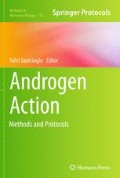Abstract
The androgen receptor (AR) plays a pivotal role in the progression of prostate cancer from the androgen-dependent to the castration-resistant state, making it a potential target for therapy. In this chapter, we describe the preparation and use of sublines of LNCaP and C4-2 human prostate cancer cells which have been engineered to stably express a doxycycline (DOX)-inducible AR shRNA in order to study the in vitro and in vivo effects of AR knockdown.
Access this chapter
Tax calculation will be finalised at checkout
Purchases are for personal use only
References
Petrylak, D. P., Tangen, C. M., Hussain, M. H., Lara, P. N., Jr., Jones, J. A., Taplin, M. E., Burch, P. A., Berry, D., Moinpour, C., Kohli, M., Benson, M. C., Small, E. J., Raghavan, D., and Crawford, E. D. (2004) Docetaxel and estramustine compared with mitoxantrone and prednisone for advanced refractory prostate cancer, N Engl J Med 351, 1513–1520.
Chen, C. D., Welsbie, D. S., Tran, C., Baek, S. H., Chen, R., Vessella, R., Rosenfeld, M. G., and Sawyers, C. L. (2004) Molecular determinants of resistance to antiandrogen therapy, Nat Med 10, 33–39.
Wang, Q., Li, W., Zhang, Y., Yuan, X., Xu, K., Yu, J., Chen, Z., Beroukhim, R., Wang, H., Lupien, M., Wu, T., Regan, M. M., Meyer, C. A., Carroll, J. S., Manrai, A. K., Janne, O. A., Balk, S. P., Mehra, R., Han, B., Chinnaiyan, A. M., Rubin, M. A., True, L., Fiorentino, M., Fiore, C., Loda, M., Kantoff, P. W., Liu, X. S., and Brown, M. (2009) Androgen receptor regulates a distinct transcription program in androgen-independent prostate cancer, Cell 138, 245–256.
Gregory, C. W., Fei, X., Ponguta, L. A., He, B., Bill, H. M., French, F. S., and Wilson, E. M. (2004) Epidermal growth factor increases coactivation of the androgen receptor in recurrent prostate cancer, J Biol Chem 279, 7119–7130.
Sadar, M. D. (1999) Androgen-independent induction of prostate-specific antigen gene expression via cross-talk between the androgen receptor and protein kinase A signal transduction pathways, J Biol Chem 274, 7777–7783.
Cheng, H., Snoek, R., Ghaidi, F., Cox, M. E., and Rennie, P. S. (2006) Short hairpin RNA knockdown of the androgen receptor attenuates ligand-independent activation and delays tumor progression, Cancer Res 66, 10613–10620.
Snoek, R., Cheng, H., Margiotti, K., Wafa, L. A., Wong, C. A., Wong, E. C., Fazli, L., Nelson, C. C., Gleave, M. E., and Rennie, P. S. (2009) In vivo knockdown of the androgen receptor results in growth inhibition and regression of well-established, castration-resistant prostate tumors, Clin Cancer Res 15, 39–47.
Downward, J. (2004) Use of RNA interference libraries to investigate oncogenic signalling in mammalian cells, Oncogene 23, 8376–8383.
Hannon, G. J., and Conklin, D. S. (2004) RNA interference by short hairpin RNAs expressed in vertebrate cells, Methods Mol Biol 257, 255–266.
Taxman, D. J., Livingstone, L. R., Zhang, J., Conti, B. J., Iocca, H. A., Williams, K. L., Lich, J. D., Ting, J. P., and Reed, W. (2006) Criteria for effective design, construction, and gene knockdown by shRNA vectors, BMC Biotechnol 6, 7.
Acknowledgments
The authors acknowledge the work of Dr Ladan Fazli, Mary Bowden, and Fariba Ghaidi in the development of these techniques in our lab. We also thank Drs Greg Hannon, Alice Mui, and Rob Kay for providing the plasmids. This work was supported by grants from the Prostate Cancer Foundation and the Canadian Institutes of Health Research.
Author information
Authors and Affiliations
Corresponding author
Editor information
Editors and Affiliations
Rights and permissions
Copyright information
© 2011 Springer Science+Business Media, LLC
About this protocol
Cite this protocol
Cheng, H., Leblanc, E., Rennie, P.S. (2011). In Vitro and In Vivo Silencing of the Androgen Receptor. In: Saatcioglu, F. (eds) Androgen Action. Methods in Molecular Biology, vol 776. Humana Press. https://doi.org/10.1007/978-1-61779-243-4_7
Download citation
DOI: https://doi.org/10.1007/978-1-61779-243-4_7
Published:
Publisher Name: Humana Press
Print ISBN: 978-1-61779-242-7
Online ISBN: 978-1-61779-243-4
eBook Packages: Springer Protocols

